

Destinations
Experiences
 |
L A
D A T C O T O U R
S |
 |
||||||||
| HOME | South America | Falkland Islands | Antarctica | Unique Destinations |
Unique Experiences |
Newsstand | ||||
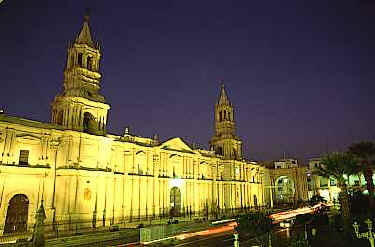 |
Arequipa "The White
City"
Parador CIRQA |
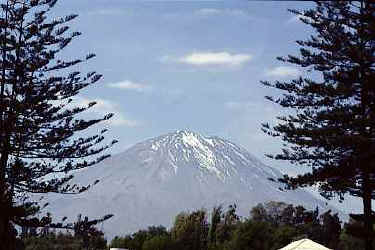 |
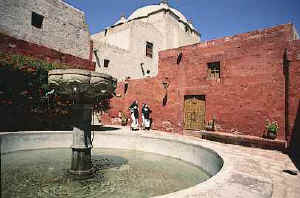 |
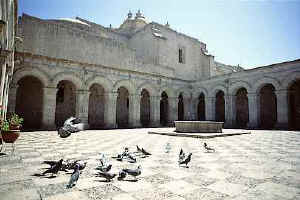 |
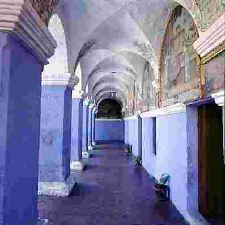 |
AREQUIPA:
Acknowledged as second most important City in Peru, Arequipa is distinguished as much for its handsome architectures and delicious food as for its eternally blue sky. No only does this City leave an indelible mark on all the one come to it but, besides, it sits at the foot of impressive Misti volcano, a true monument of nature.The White City, called so because of its buildings made of white petrified volcanic ash thrown up by Chancani volcano, is an example of a mix of Italian, Spanish and Andean styles. This power of attraction is summed up in the Quechua phrase "ari, que pay" (yes, stay!), the answer Inca Mayta Capac gave to his warriors when they asked him to let them make a halt in this lovely land.
Years later, on August 15, 1540, the Spanish founding would take place. Manuel Garcia de Carbajal baptized it, in the name of the Queen of Spain, as Villa de Nuestra Senora de la Asuncion del Valle Hermoso de Arequipa, since then it has acquired many characteristics that set it apart from the rest of Peruvian cities.
LOCATION:
The City of Arequipa, capital of the Department of the same name is located in the southwestern part of the Peruvian coast. It has a surface area of 63,527.62 km. only 23,500.20 km2 of coast. It is at 71 degrees 32 west longitude, 16 degrees 24 South latitude, and an altitude of 2,304 meters above sea level.CLIMATE:
Warm on the coast, temperature in the Andean valleys, cold on the plateau, and glacial on the summits of the western, volcanic mountains range. The sun shines year-round, and the rain season is from January to March. The maximum temperature is 23 C and the minimum drop down to as low as 5 C at dawn in the winter.MAIN POINTS OF INTEREST - In the City:
SANTA CATALINA MONASTERY : Monastic architectural masterpiece that remained hidden until 1970. After 400 years, it has been reopened to the public displaying ashlar stone constructions with more than 20,426 m2. Here the visitor finds the Cloister of the Orange Trees, The "De Profundis" Salon, Cordoba street (white colored), Sevilla street, and Zacodober Plaza with its beautiful granite basin. There is also a picture gallery that holds paintings of the Cusco School and landscapes of Santa Catalina de Sena.
THE CATHEDRAL: The ancient cathedral was destroyed by the fire in 1844 and in two years was restored in a Renaissance style with French influence by from Arequipa Lucas Poblete. The facade occupies one side of the main square and exhibits two bronze medallions, symbols of the Peru-Bolivia confederation. It has three large portals and holds a high altar of Italian Carrara marble made by Felippo Moratilla, a pulpit carved in wood by the French artist Rigot, and an organ made in Belgium.
CHURCH AND CLOISTER OF THE COMPANY: From the XVII century possessing a plateresque style facade, Baroque style gold leaf altars and pulpit. The sacristy is decorated with polychrome paintings of animal and plant shapes and with Cusco and Bitti School canvases. The Jesuit Cloisters display a Baroque-Mestizo (half-breed) style with three patios. The entire building is made of ashlar stone.
Other attractions include:
- San Francisco Church
- Santa Teresa Monastery
- San Agustin Church
- La Recoleta
MANORS:
- Home of the Blackberry Bush: Owes its name to a blackberry tree that is found in its patio. It is the prototype of the XVII century manor displaying its beautiful mestizo portal inlaid in ashlar stone, today it is the seat of the Banco Industrial.
- Goyeneche Palace: There are three: two in the country (Huasacache and Sachaca) and the other in the city on 201 La Merced Street. Today it is the seat of the Banco de Reserva.
- Others of interest: Tristan del Pozo Manor, La Moneda Manor, Irribery Manor, Los Pastor Manor, Los Mendiburos Manor
JUANITA, THE ICE MAIDEN
From Wikipedia, the free encylopedia (shortened by LADATCO; full version available on Wikipedia)Momia Juanita (Spanish for "Mummy Juanita"), better known in English as the "Ice Maiden," is an Inca mummy of a girl, between 12-14 years old, who died sometime between 1440 and 1450. She was discovered in southern Peru in 1995 by anthropologist Johan Reinhard and his Peruvian climbing partner Miguel Zarate. Also known as the Lady of Ampato and the Frozen Lady, Juanita toured the United States in 1996 and Japan in 1999 before returning to Peru.
Discovery:
Johann Reinhard had made various ascents in several mountain ranges like the Himalayas (in Nepal) and the Peruvian Andes. As an archaeologist, he had studied Machu Picchu, Chavín and the Nazca Lines. He became very familiar with the Peruvian heights and the nature of the country's native inhabitants. For him and his partner, Miguel Zárate, a guide from Arequipa, it became a regular routine to climb the Apus, legendary mountain spirits that Peruvians have feared and worshipped since the time of the Inca.In 1995, during an ascent of Mt. Ampato, Reinhard and Zarate found inside the summit crater a bundle that had fallen down from an Inca site when the ridge had collapsed due to the melting caused by volcanic ash that has fallen from the nearby erupting volcano of Sabancaya. To their astonishment, the bundle turned out to contain a remarkably well-preserved mummy of a young girl. In addition, they found—strewn about the mountain slope down which the mummy had fallen—many items that had been left as offerings to the Inca gods, such as statues and food items. A couple of days later, the mummy and the objects were taken to Arequipa; the remains of the mummy were initially kept in a special refrigerator.
The mummy caused a sensation in the scientific world due to the well-preserved state in which it was found. Between May and June of 1996, the mummy was exhibited in the headquarters of National Geographic Society in Washington D.C., in a specially acclimatized conservation/display unit. In its June 1996 edition, National Geographic also included an article dedicated to the discovery of Juanita and in 2005 Johan Reinhard published a detailed account in his book The Ice Maiden: Inca Mummies, Mountain Gods, and Sacred Sites in the Andes Washington, D.C.: National Geographic Society.
Identity:
This young girl's body was taken to the United States and went through to a virtual autopsy in the laboratories of Johns Hopkins Hospital in Baltimore, Maryland. The mummy had tomographies taken, as well as X-ray examinations. Scientists reached the following conclusions about Juanita:
- she had died at the age of 14, between approximately 1440 and 1450;
- she had had a stature of 1.40 meters;
- she had weighed 80 pounds at the time of death;
- she was slender in build and body shape;
- she had not suffered of any illness;
- she had had a perfect denture and strong bones;
- she had had a good and well-balanced diet;
- she had fasted one day before the sacrifice;
- she had a 5cm fissure in the skull ; and
- she had died from blunt force trauma to the head
It is believed by some archaeologists that the Ice Maiden was in fact a human sacrifice to the Inca mountain god (Apus). The Ice Maiden was then buried by the Inca priests atop Mount Ampato (20,700 feet, or 6,309 m) in Peru, and left undisturbed until discovered by Johann Reinhard in 1995.
Whereabouts:
Juanita is now housed in the Museum of the Universidad Católica de Santa María of Arequipa, Peru. She is currently encased in a special glass box at a constantly cold temperature to continue preserving her body. The interior of the urn is kept at a temperature between -19.2 °C and -19.5 °C to avoid the dehydration of her body.In the same museum are "Urpicha" (palomita, "little dove" in Spanish, a mummy found on the volcano Pichu Pichu of Arequipa); "Sarita" (found on the Sarasara volcano, between Arequipa and Ayacucho), and five other mummies found in El Misti volcano, also near Arequipa.
OF INTEREST IN THE ENVIRONS:
Cayma: 3 km from the center of the City called "Arequipa's Balcony" due to its view of the whole city. A Baroque-Mestizo church (1730) is found here. The Festivity of the Candelaria Virgin is traditional here (February 2).
Yanahuara: 2 km from the center of the City. A legendary villa close (to the City with narrows) small streets and old homes with family orchards. Its 1750 built church is famous. It is located in the main square and has a Baroque facade and a frugal interior. The Yanahuara Observatory is an esplanade with ashlar stone archways.
Socobaya: 10 km from Arequipa, beautiful scenery, a paradise for poets and writers. Here the visitor finds natural caves (Las Penas) in the form of drains that distill water.
Chilina: Area with romantic scenery located on the length of the Cili river. It is the most beautiful area of the Arequipa countryside. The Molino Blanco (white mill). Former mill of St. Catalina is also located here.
Dead Bull Ancient Engraved Stones: Located in the Majes valley in an area of 5 km extended between 400 and 800 meters above sea level. It is probably the world's richest area in rupestrian art. It has more than 6,000 blocks of stone engraved in low relief of approximately 1,200 years of antiquity.
The Colca Canyon: Located in the province of Cailloma in Cabanaconde. Two or three days are recommending for a visit staying overnight in Achoma. The trip toward the Canyon is extremely interesting due not only to its scenic beauty but also to what it presents along the way: Evidence of the agricultural predominance of the ancient Peruvian culture, the large number of platforms, colonial architectonic monuments in picturesque towns, flora (variety of cactuses), and fauna (auquenidos, birds, condors). The Canyon has more than 100 km length, and its deepening (the deepest point being 3,400 meters) starts km after Chivay. The best observatory is 3,800 meters above sea level. The Colca Region is highly appropriate for adventure tourism.
Majes Valley: Located between 200 an 800 meters above sea level; fertile valley with warm climate year round because it is connected to a valley that is a continuation of the COLCA. Upon their arrival the Spaniards were impressed with this canyon, and they baptized it as the Mages-tuoso (Majesty) Valley; this, the name, MAJES. The main activities of its inhabitants are agriculture and shrimp fishing. The most common sports are CANOEING and DELTA WING flying. The entire valley has a longitude of 80 km, and along the way one finds stone carvings, Pre-Inca cemeteries, rupestrian paintings, etc.
Valley of the Volcanoes: 377 km from Arequipa in Andagua in the province of Condesuyos behind the snowy peak of "Coropuna" located at an altitude of 3,450 meters above sea level with perpetual snow The visitor can enjoy a large quantity of fauna and natural scenery. There are 60 adjacent volcanoes, 30 of which posses a fissure with vegetation on their peaks.
Artisanship:
The Arequipa Artisan work is well known for its excellent finish in rugs, in plate candlesticks, trays, iron lanterns, chess games, necklaces, bracelets, leather buttons, cigar cases, trunks, tables and ashlar stone decorations, flowerports, lamp stands, decorative bronze plates, silverwork, embroidered baize chests guitars, mandolins, charangos, (small chord instrument used by natives), saddles, shawis, sweaters, and spun alpaca ponchos. The material used are ashlarstone, forged iron, leather, textiles, and wood.